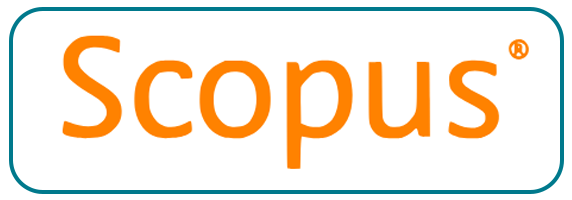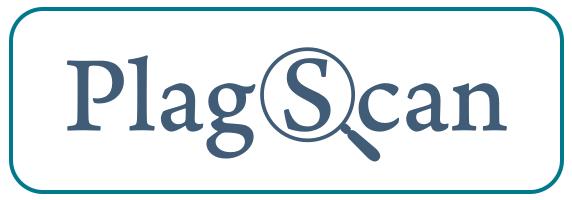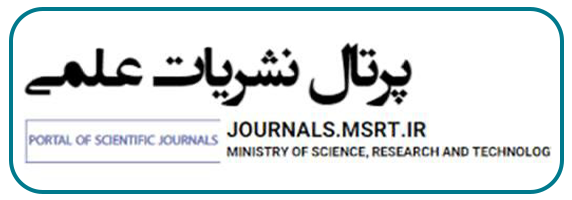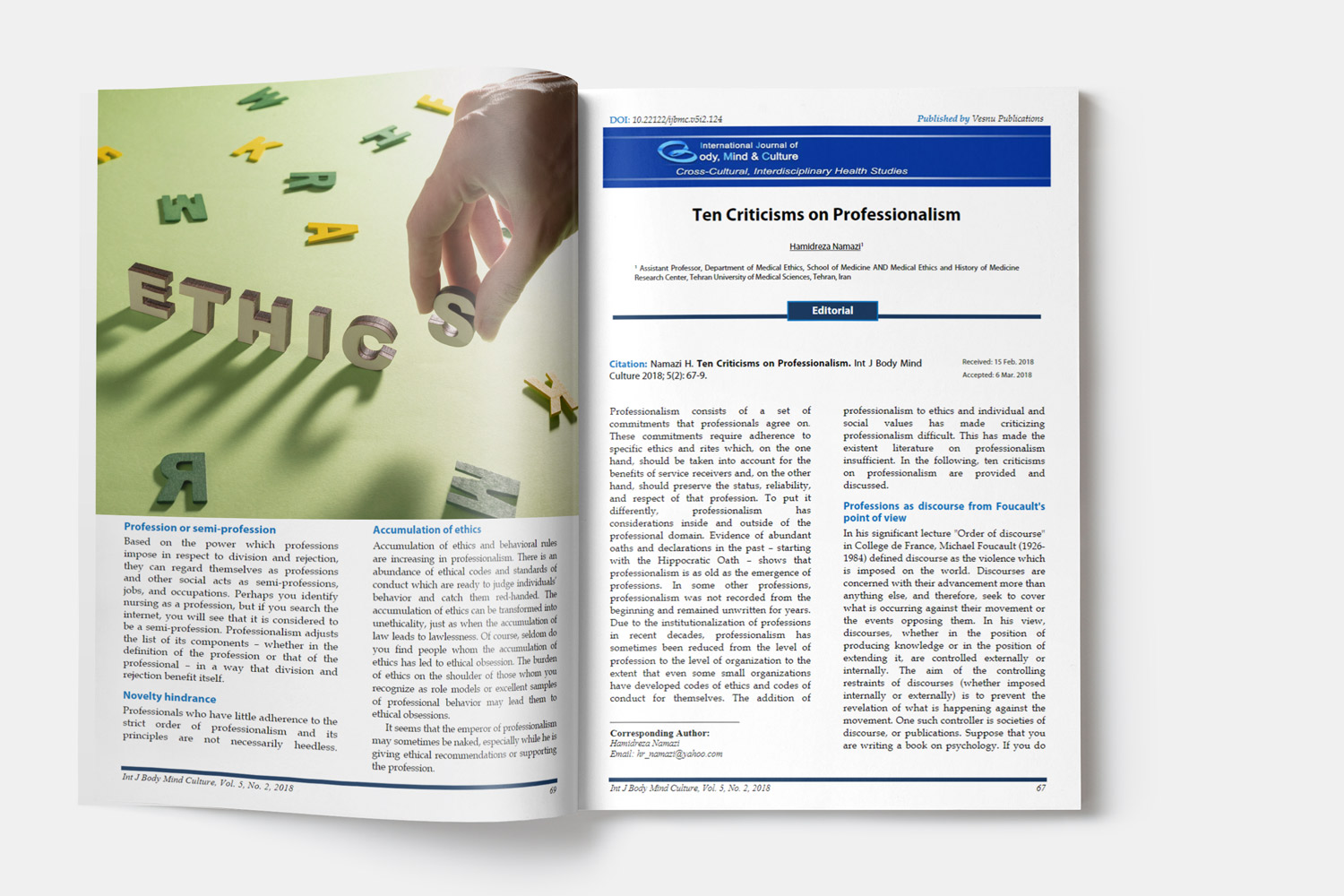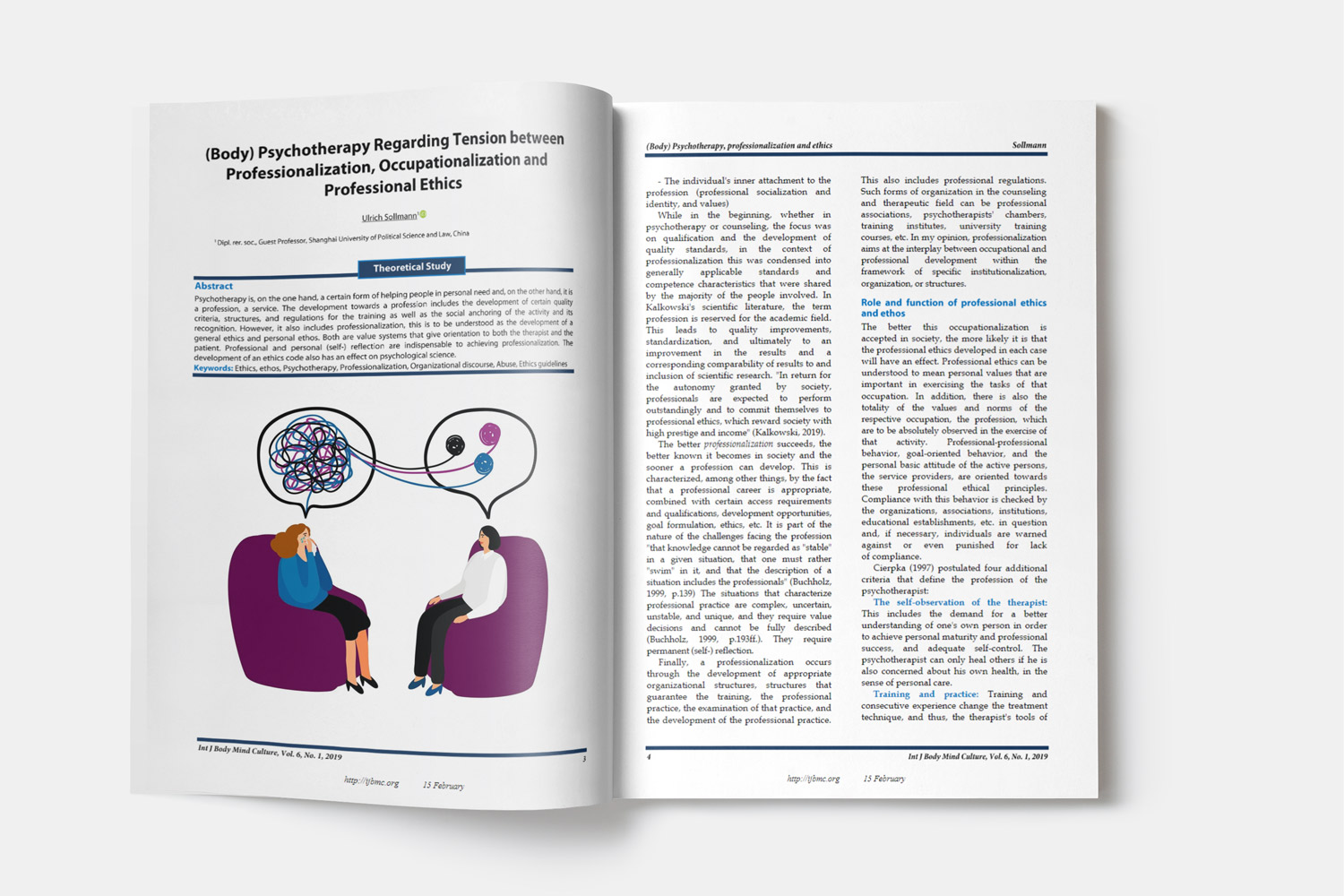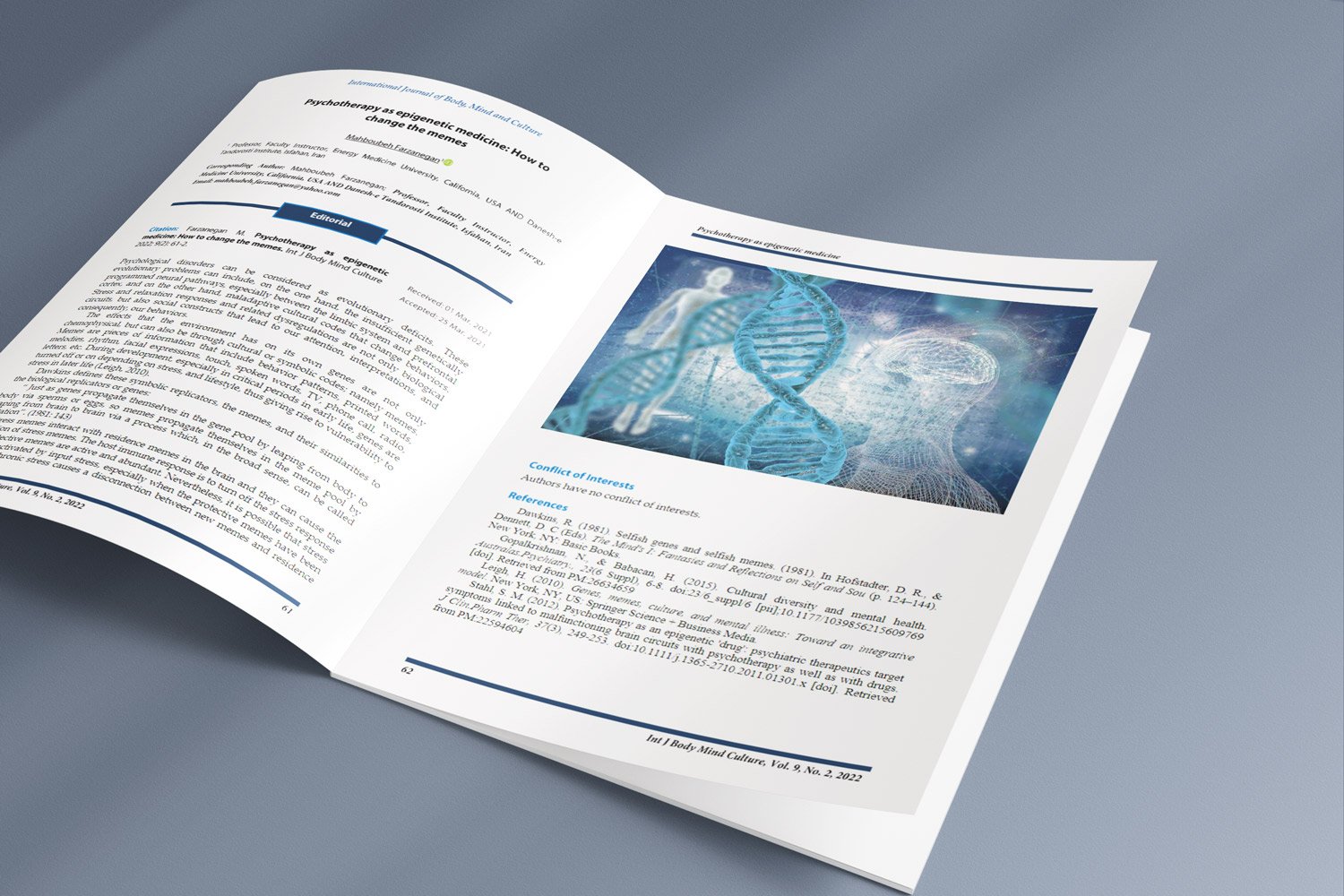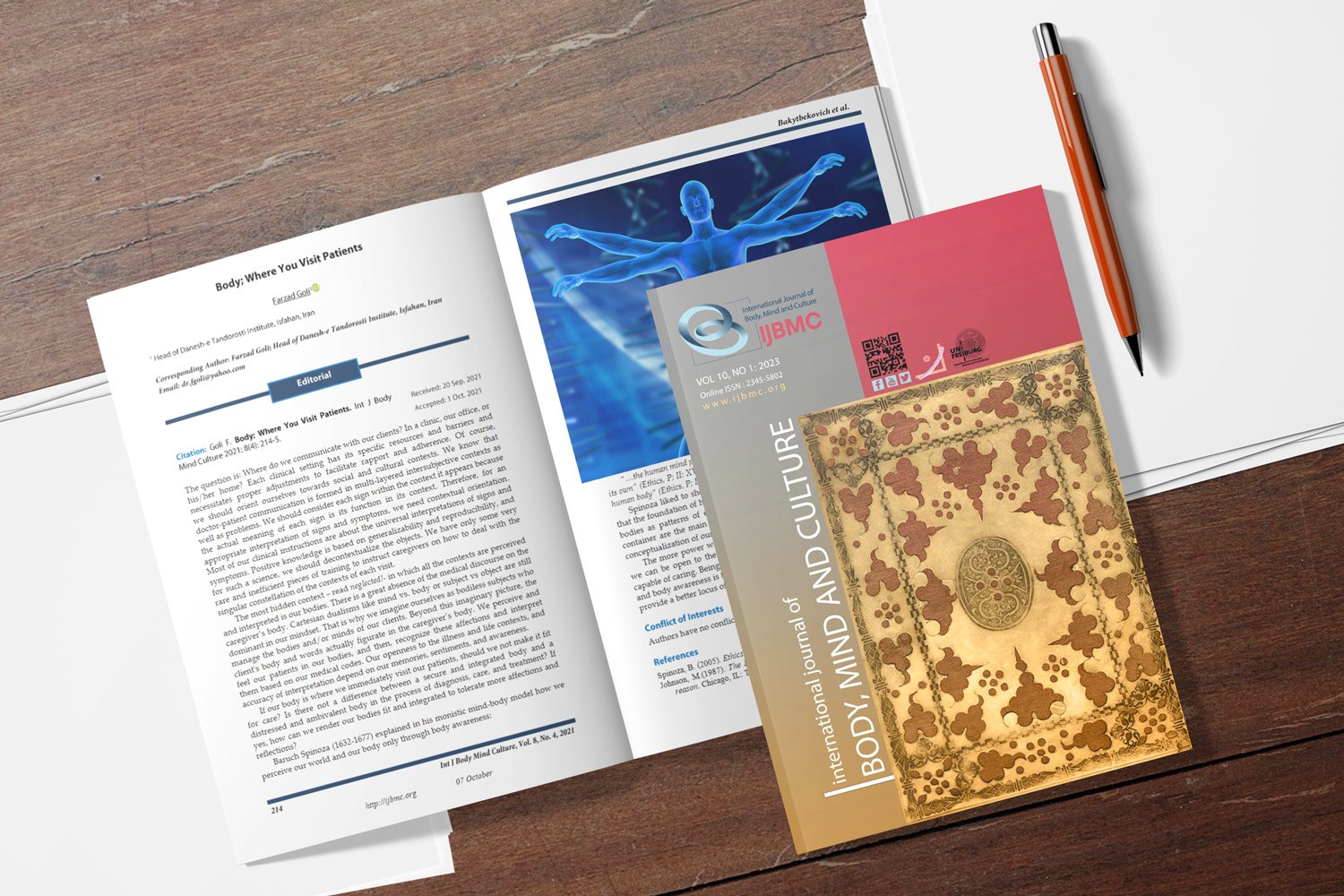Bioenergy Economy, Fields and Levels: A Narrative Review
Downloads
The key point which is dealt with in this essay is the question of many philosophers, economists, and psychologists from Buddha, Socrates, and Epicurus to Adam Smith, Bentham, Freud, Reich, and Kahneman; the question of satisfaction and liberation from pain and boredom. Bioenergy economy (BEE) is introduced as a phenomenal-contextual, evolutionary, and metadiagnostic care system that facilitates the sustainable development of happiness. BEE follows its aim through using cognitive, behavioral, physical, energetic, and transpersonal modalities. This approach originates in the dynamic conventions of Freud, Lacan, Lyotard, and Deleuze's libidinal economy on the one hand and energy healing traditions such as yoga, qigong, and reiki on the other. Based on an economic and evolutionary model, BEE is employed to reach salutogenesis and consciousness evolution through integrating the four fields of body, narrative, relations, and intention (BEE fields). To do this, we need to cathect onto more proactive and agapistic levels of pleasure rather than cumulative and releasing ones (BEE levels). BEE uses biosemiotics as a common language for sublimating cumulative and releasing levels and following material, symbolic, reflective, and energetic signs in physical, symbolic, and existential worlds.
Downloads
Ahangar Ahmadi, A., Henning, J. E. & Goli, F. (2017). Awakening teachers to their presence: An experiential course in body wisdom. The Practitioner Scholar: Journal of Counseling and Professional Psychology, 6, 92-107.
Antonovsky, A. (1979). Health, stress, and coping. San Francisco, CA: Jossey-Bass.
Bakir, A. & Todorovic, M. (2010). A hermeneutic reading into "What Strategy is": Ambiguous means-end relationship. The Qualitative Report, 15(5), 1037-1057.
Barbieri, M. (2001). The organic codes. The birth of semantic biology. Cambridge, UK: Cambridge University Press.
Benor, D. J. (2000). Intuitive diagnosis. In: Keegan, L., Guzzetta, C. E. (Eds). Holistic nursing: A handbook for practice. Gaithersburg, MD: Aspen.
Brentano, F. (1995). Psychology from an Empirical Standpoint. (A. C. Rancurello, Terrell, D. B, & McAlister, L. Trans.). L. Oxford, UK: Routledge.
Brier, S. (2016) Cybersemiotics as a Transdisciplinary Model for Interdisciplinary Biosemiotic Pharmacology and Medicine. In: Goli F. (Eds) Biosemiotic Medicine. Studies in Neuroscience, Consciousness and Spirituality. vol 5. Cham, Switzerland: Springer, Cham; p. 23-84.
Cohen, D. (2004). Boston and the history of biomagnetism. Neurol.Clin.Neurophysiol., 2004, 114.
Damasio, A., & Carvalho, G. B. (2013). The nature of feelings: evolutionary and neurobiological origins. Nat.Rev.Neurosci., 14(2), 143-152.
Derakhshan, A., Manshaei, G., Afshar, H., & Goli, F. (2016). Effect of a bioenergy economy program on pain control, depression, and anxiety in patients with migraine headache. Int J Body Mind Culture, 3(1), 30-45.
Dossey, B., Keegan, L., Guzzeta, C., & Kolkmeier L. (1995). Holistic nursing: A handbook for practice. Gaithersburg, MD: Aspen Publishers.
Ellis, A. (2001). Feeling better, getting better, staying better: Profound self-help therapy for your emotions. Atascadero, CA: Impact Publishers.
Freud, S. (1997). Formulations Regarding the Two Principles 1911. In: P. Rieff (Eds). General Psychological Theory: Papers on Metapsychology (1st ed). New York, NY: Touchstone.
Geoba.se (2018). The World: Life Expectancy (2018). Retrieved from: URL: http://www.geoba.se/population.php?pc=world&type=015&year=2018&st=country&asde=&page=2
Goli, F. (2008). Hich inja mihichad [Naught is naughting here]. Tehran, Iran: Asim.
Goli, F. (2010). Bioenergy Economy: A Methodological Study on Bioenergy-Based Therapies. Bloomington, IN: Xlibris.
Goli, F. (2016a). Bioenergy Economy: A Biosemiotic Model of Care. Int J Body Mind Culture, 3(1), 1-7.
Goli, F. (2016b). Medical Practice in/with the Semiosphere. In H. Walach & S. Schmidt (Eds.), Studies in Neuroscience, Consciousness and Spirituality (pp. 217-239). Cham, Switzerland: Springer.
Goli, F., & Boroumand, A. R. (2016). Back to Future Health Blueprint: The Effects of a Brief Bioenergy Economy Program on a Patient with Tethered Cord Syndrome. Int J Body Mind Culture, 3(1), 64-69.
Haken, H. (1983). Synergetics: An introduction: Nonequilibrium phase transitions and self-organization in physics, chemistry, and biology. New York, NY: Springer.
Hall, E. T. (1990). The Hidden Dimension. A Doubleday anchor book. New York, NY: Anchor Books.
Halperin, E. C. (2001). Should academic medical centers conduct clinical trials of the efficacy of intercessory prayer? Acad.Med., 76(8), 791-797.
Heidegger, M. (2008). Being and Time. Harper Perennial Modern Thought. (J. Macquarrie & Robinson, E. Trans. ). New York, NY: HarperCollins.
Hofmann, S. G., Sawyer, A. T., Witt, A. A., & Oh, D. (2010). The effect of mindfulness-based therapy on anxiety and depression: A meta-analytic review. J Consult.Clin.Psychol., 78(2), 169-183.
Ingber, D. E. & Folkman, J. (1989). Tension and compression as basic determinants of cell form and function: utilization of a cellular tensegrity mechanism. In W. Stein & F. Bronner (Eds.). Cell Shape (pp. 1-32). Orlando, FL: Academic Press.
Ingber, D. E. & Jamieson, J. D. (1985). Cells as tensegrity structures: Architectural regulation of histodifferentiation by physical forces transduced over basement membrane. In L. C. Anderson, C. G. Gahmberg, & P. Ekblom (Eds.), Gene expression during normal and malignant differentiation (pp. 13-32). Orlando, FL: Academic Press.
Jacobson, E. (1934). Electrical measurements concerning muscular contraction (tonus) and the cultivation of relaxation in man: Relaxation-times of individuals. American Journal of Physiology-Legacy Content, 108(3), 573-580.
Jacobson, E. (1938). Progressive relaxation (2nd ed.). Oxford, England: University of Chicago Press.
Jacobson, E. (1976). You must relax. London, England: Souvenir Press.
Jahn, R. G. (2001). The challenge of consciousness. Journal of Scientific Explorations, 15(4), 443-457.
Jaynes, J. (1976). The origin of consciousness in the breakdown of the bicameral mind. New York, NY: Mariner Books.
Johnson, M. (1990). The Body in the Mind: The Bodily Basis of Meaning, Imagination, and Reason. Chicago, IL: University of Chicago Press.
Jung, C. G. (1969). On the Nature of the Psyche. Princeton, NJ: Princeton University Press.
King, J. E., & McLure, M. (2014). History of the Concept of Value (Economics Discussion / Working Papers 14-06). Crawley, WA, Australia: Department of Economics, The University of Western Australia.
Kohlberg, L. (1973). The claim to moral adequacy of a highest stage of moral judgment. Journal of Philosophy, 70(18), 630-646.
Kövecses, Z. (2003). Metaphor and Emotion: Language, Culture, and Body in Human Feeling. Cambridge, UK: Cambridge University Press.
Kurtz, R., & Prestera, H. (1977). The body reveals: an illustrated guide to the psychology of the body. Oxford, UK: Harper & Row.
Lamm, C., & Majdandzic, J. (2015). The role of shared neural activations, mirror neurons, and morality in empathy--a critical comment. Neurosci.Res., 90, 15-24.
Levine, J. (1985). The Man Who Says Yes. Johns Hopkins Magazine, 36(1), 34.
Levold, T., & Goli, F. (2017). East meets West. Sufismus und systemische Konzepte im Iran. Kontext, 48(4), 368-385.
Lindström, B., Eriksson, M. (2006). Contextualizing salutogenesis and Antonovsky in public health development. Health Promot Int., 21(3), 238-244.
Maturana, H. R., & Varela, F. J. (1991). Autopoiesis and Cognition: The Realization of the Living. London, England: D. Reidel Publishing Company.
May, R. (2015). The discovery of being. New York, NY: W. W. Norton.
Mollon, P. (1991). Psychotherapists heal thing attitude. Presented at Symposium on the Crucial Factor in Psychotherapy and Psychoanalysis. Department of Psychotherapy, Manchester Royal Infirmary, 4 November.
Myers, T. W. (1997a). The anatomy trains: Part 2. Journal of Bodywork and Movement Therapies, 1(3), 135-145.
Myers, T. W. (1997b). The anatomy trains. Journal of Bodywork and Movement Therapies, 1(2), 91-101.
Nelson, R. D. (1999). The Physical Basis of Intentional Healing Systems (PEAR Technical Note 99001). Princeton, NJ: Princeton Engineering Anomalies Research.
Numbeo (2018). Quality of Life Index for Country 2018 Mid-Year. Retrieved from: URL: https://www.numbeo.com/quality-of-life/rankings_by_ country.jsp?title=2018-mid&displayColumn=0
Oschman, JL. (1993). Sensing solitons in soft tissues. Guild News, the new magazine for the Guild for Structural Integration, Boulder, Colorado, 3: 22–25.
Oyserman, D. (2015). Values, Psychology . In J. Wright (Ed.), International Encyclopedia of the Social and Behavioral Sciences (2nd ed., Vol. 25, pp. 36-40). Philadelphia, PA: Elsevier.
Peirce C.S. (1893). Evolutionary Love. The Monist, 3(2), 176-200.
Plato. (1972). Plato's Philebus. (R. Hackforth, Trans. ). Cambridge, UK: Cambridge University Press.
Rafienia, P., Bigdeli, I., Sabahi, P., Goli, F., Keyvanipour, M. (in press). The effects of a bioenergy economy (BEE) based program on attention bias modification in people with high anxiety sensitivity. Iran J Med Sci.
Ritchie, H. & Roser, M. (2018). Mental health. Retrieved from: URL: https://ourworldindata.org/ mental-health
Riva, G., Dakanalis A. (2018). Altered processing and integration of multisensory bodily representations and signals in eating disorders: A possible path toward the understanding of their underlying causes. Front Hum Neurosci, 12,49.
Rogers, E. M. (2000). The Extensions of Men: The Correspondence of Marshall McLuhan and Edward T. Hall. Mass Communication and Society, 3(1), 117-135.
Rolf, I., P. (1963). Structural integration: Gravity, an unexplored factor in a more human use of human beings. Journal of The Institute for the Comparative Study of History, Philosophy and the Science, 1(1), 67–74.
Rolf, I. P. (1962). Structural Integration: Gravity, an Unexplored Factor in a More Human Use of Human Beings. Salt Lake City, UT: Guild for Structural Integration.
Rolf, I. P. (1977). Rolfing: The integration of human structures. Santa Monica, CA: Dennis-Landman.
Rome, D. I. (2014). Your Body Knows the Answer: Using Your Felt Sense to Solve Problems, Effect Change, and Liberate Creativity. Boston, UK: Shambhala.
Safavifard, S. & Goli, F. (2018). Comparative effectiveness of bio-energy economy with cognitive therapy based mindfulness on depression, anxiety, and physical symptoms in patients with irritable bowel syndrome [PhD Thesis]. Isfahan, Iran: Khorasgan Branch, Islamic Azad University.
Sartre, J. P. (1962). Existential psychoanalysis. (H. E, Barnes, Trans. ). Washington DC: Regnery Gateway.
Schopenhauer, A. (2010). The world as will and representation .(J Norman, J., Welchman, J., Janaway, C, Trans. ) (Vol 1). Cambridge, UK: Cabridge University Press.
Siegel, D. J. (2005). The Developing Mind: How Relationships and the Brain Interact to Shape Who We Are (2nd ed). New York, NY: Guilford Publications.
Sierpina, V. S. & Sierpina, M. (2004). Spirituality and health. In B. Kligler & R. Lee (Eds.), Integrative medicine: Principles for Practices (pp. 301-31). New York: McGraw-Hill.
Sutton, A. (2018). Distinction entre authenticité et constance de personnalité dans la prévision du bien-être: une approche de méthode mixte [Distinguishing between authenticity and personality consistency in predicting well-being: A mixed method approach]. Revue Européenne de Psychologie Appliquée, 68(3), 117-130.
Wilber, K. (1993). The Spectrum of Consciousness. Wheaton, IL: Quest Books.
World Health Organization (2017). Suicide rates, age stansardized-data by country. Retrieved from URL: http://apps.who.int/gho/data/node.main.MHSUICIDEASDR?lang=en. Accessed 2017 April, 13.
World Health Organization (2018). Global Health Observatory (GHO) data. Retrieved from URL: https://www.who.int/gho/mortality_burden_disease/life_tables/en/
Zahn, R., Garrido, G., Moll, J., & Grafman, J. (2014). Individual differences in posterior cortical volume correlate with proneness to pride and gratitude. Soc.Cogn Affect.Neurosci., 9(11), 1676-1683.
Copyright (c) 2018 Farzad Goli

This work is licensed under a Creative Commons Attribution-NonCommercial 4.0 International License.

